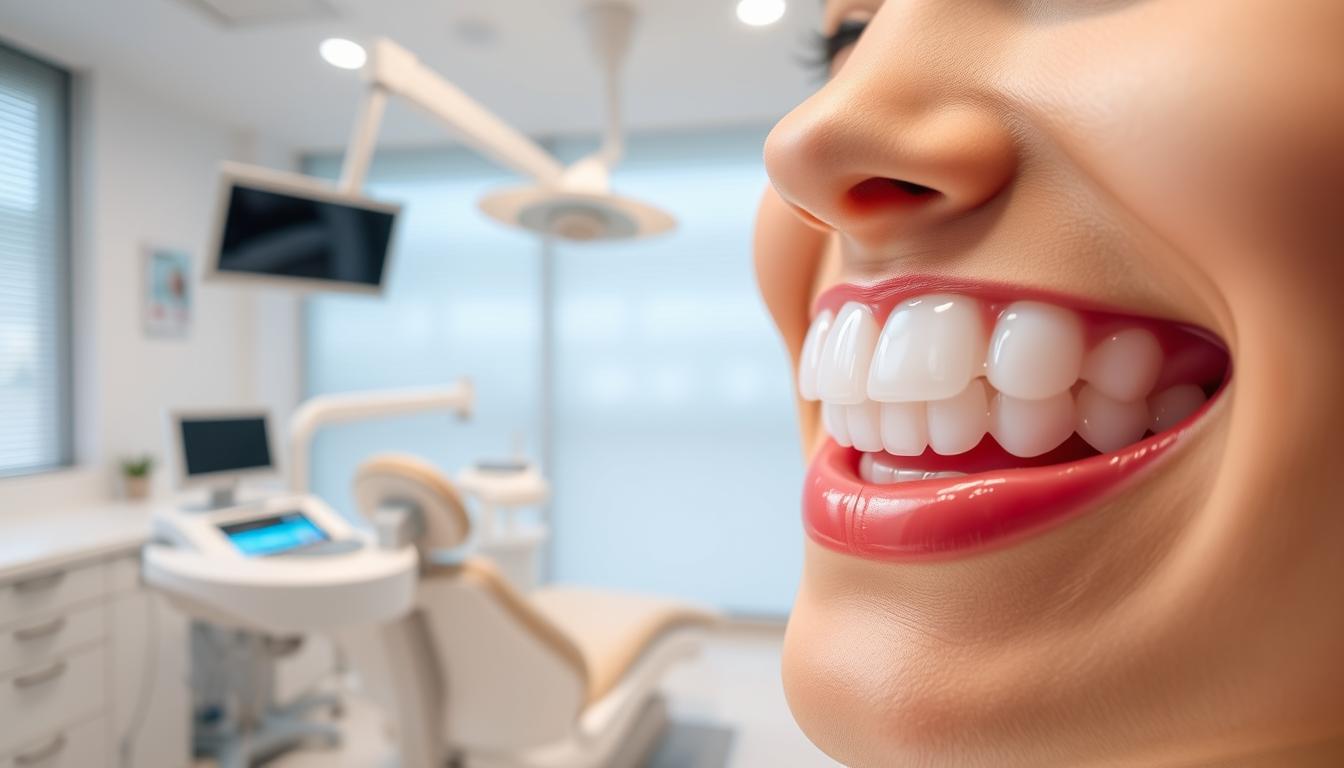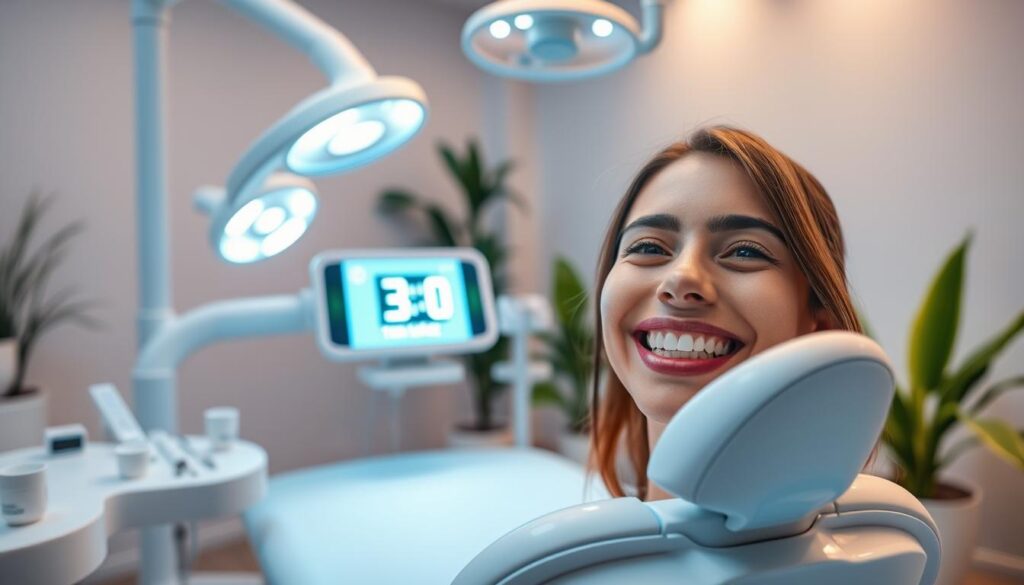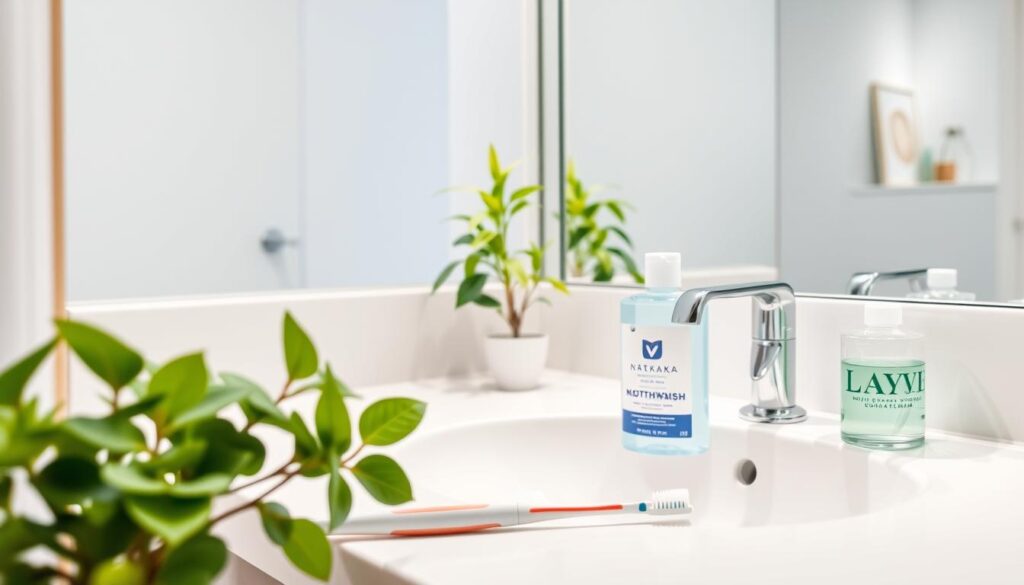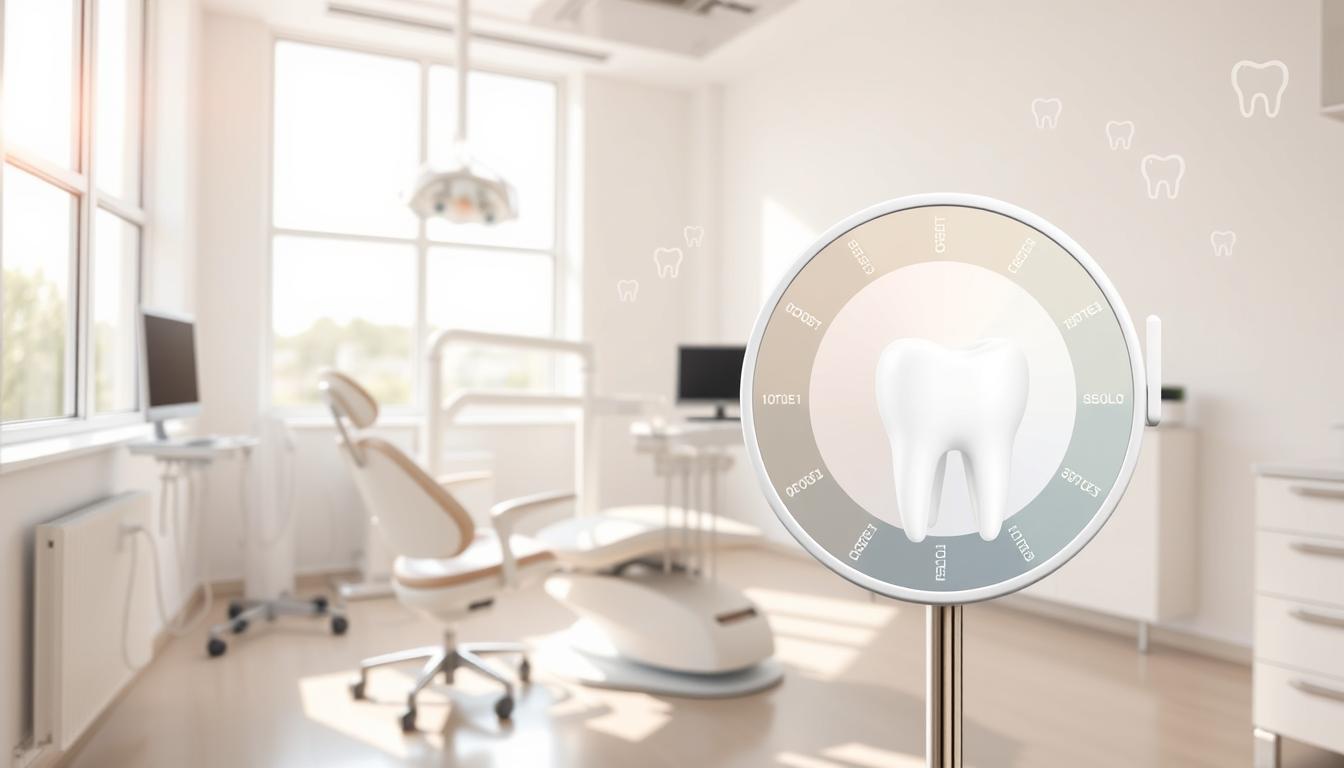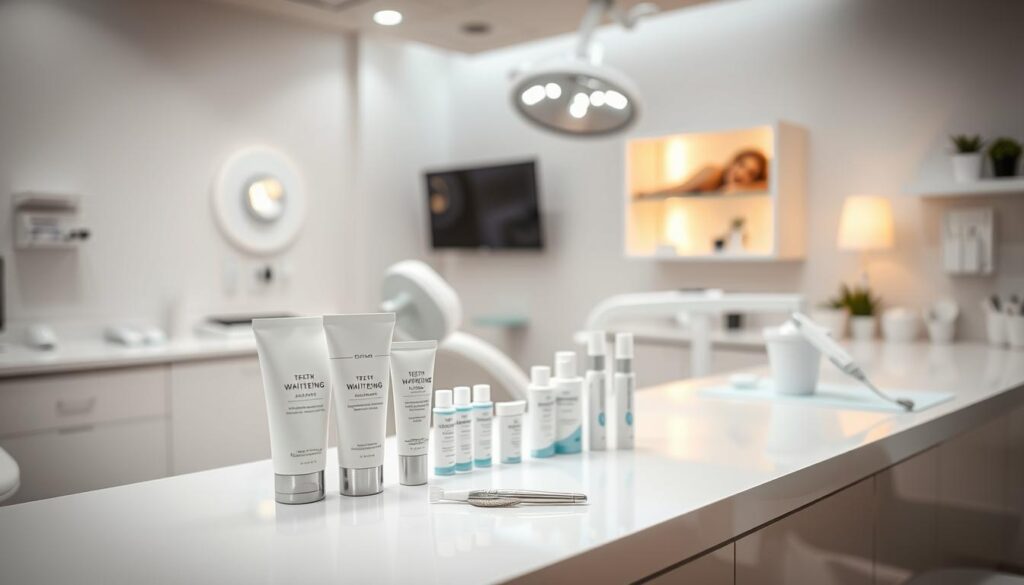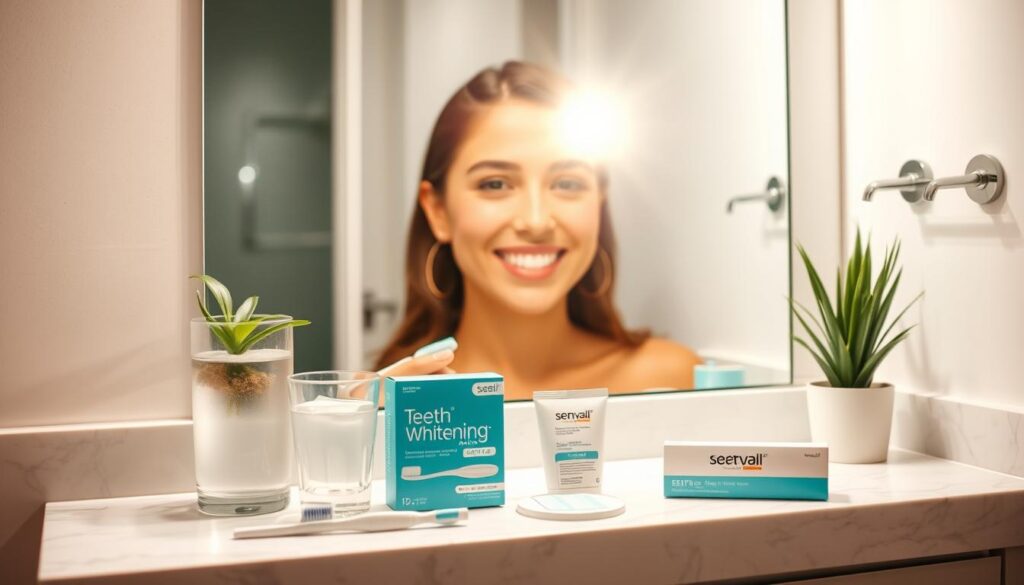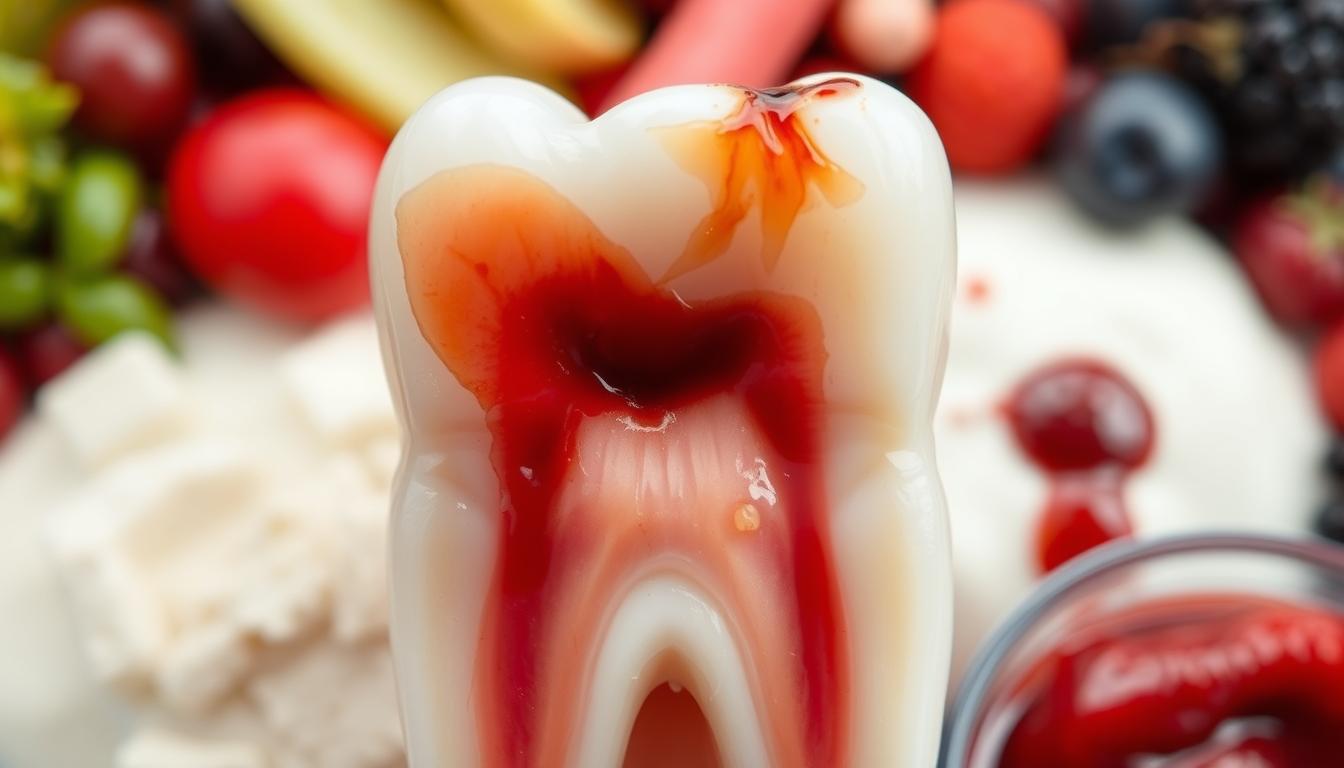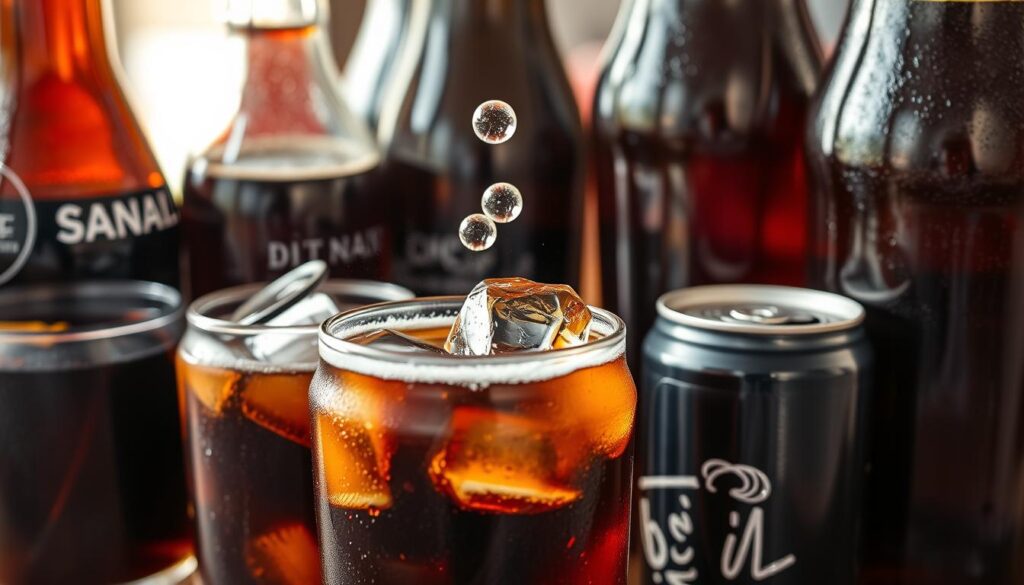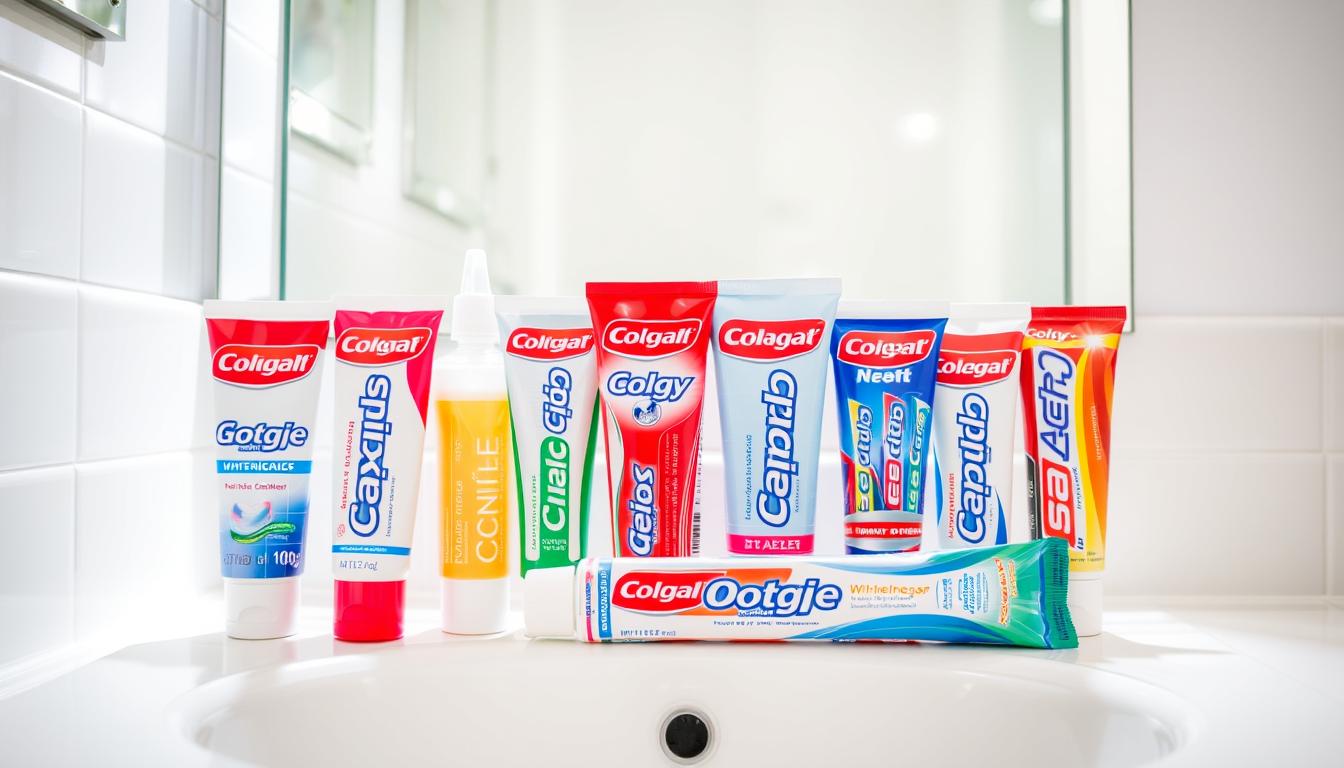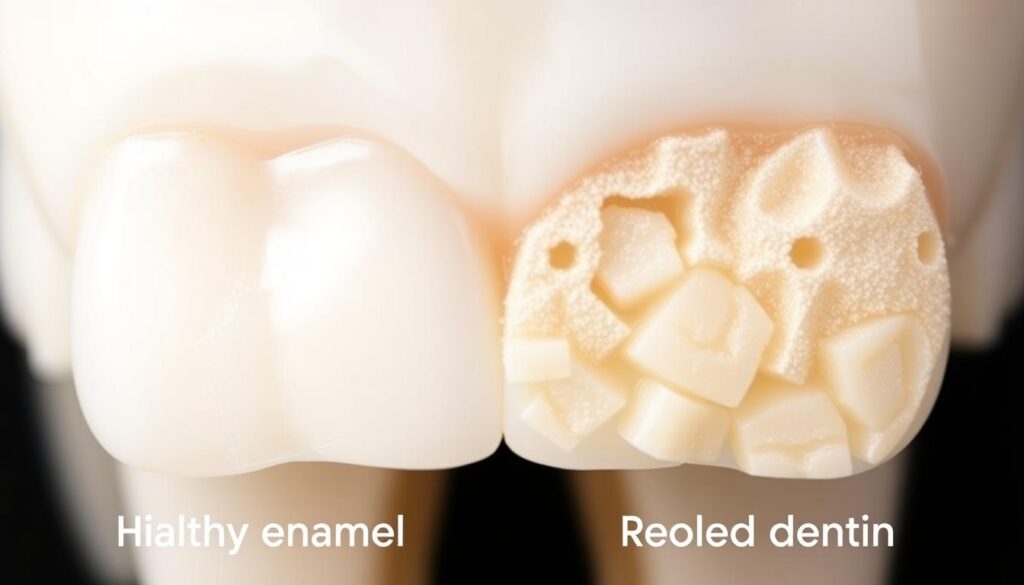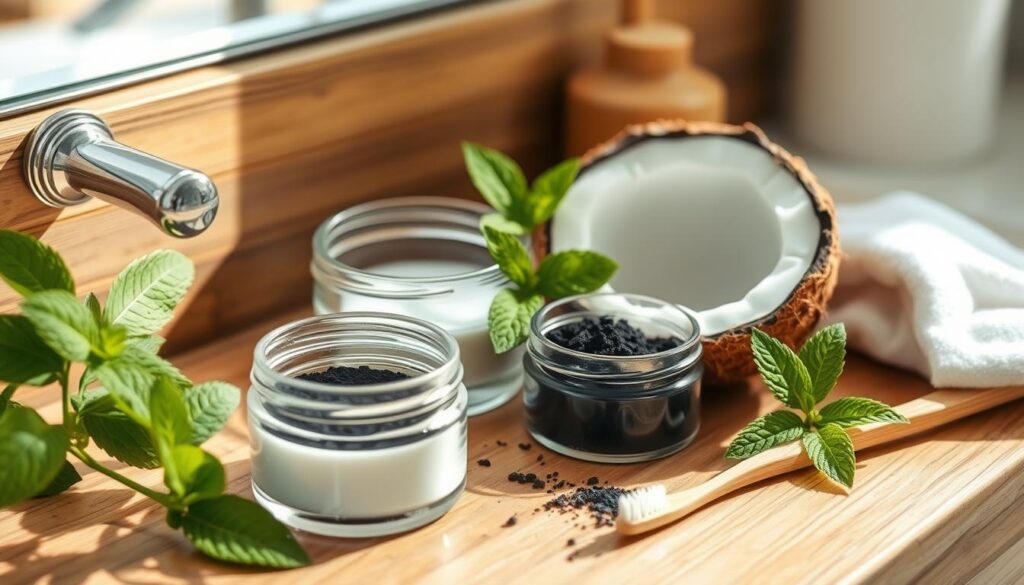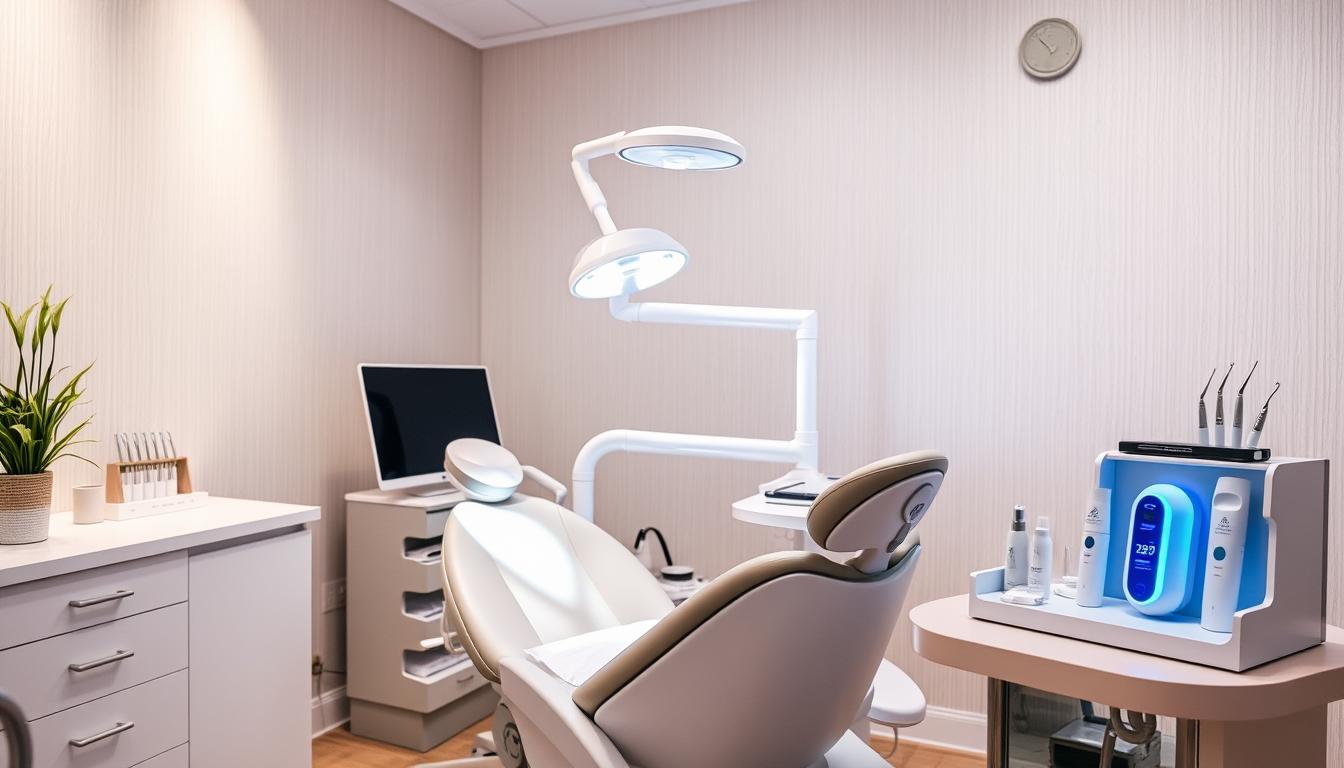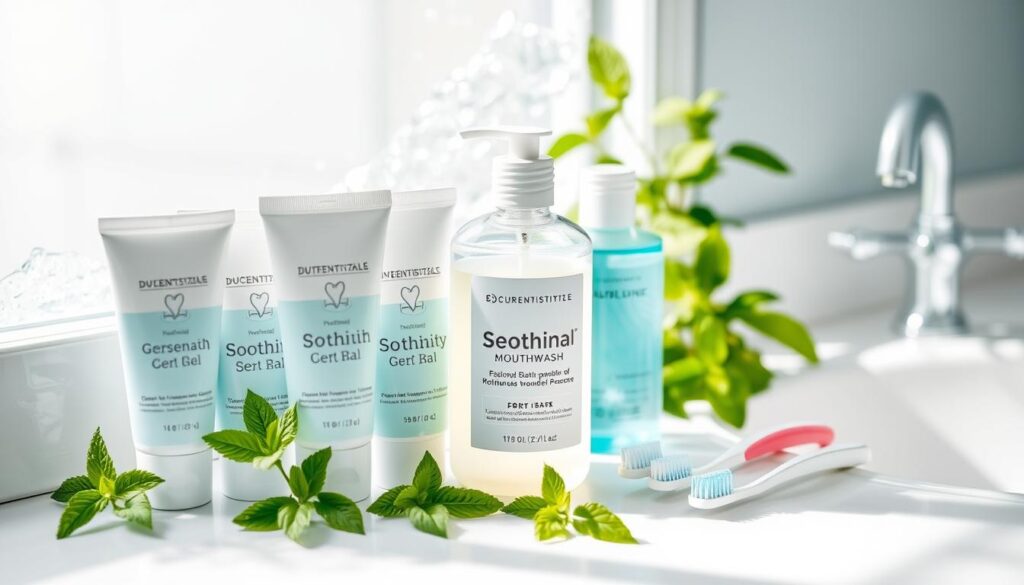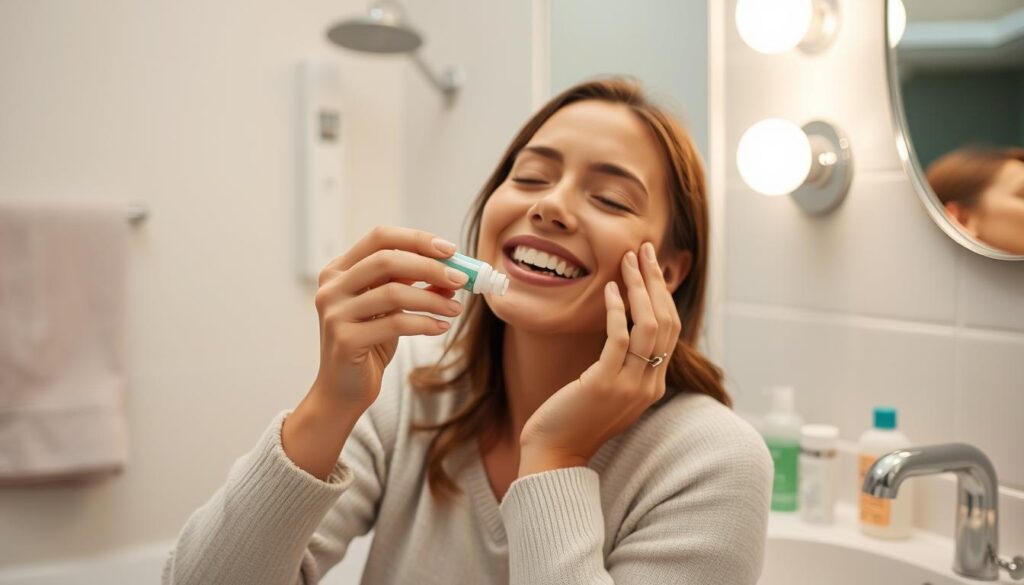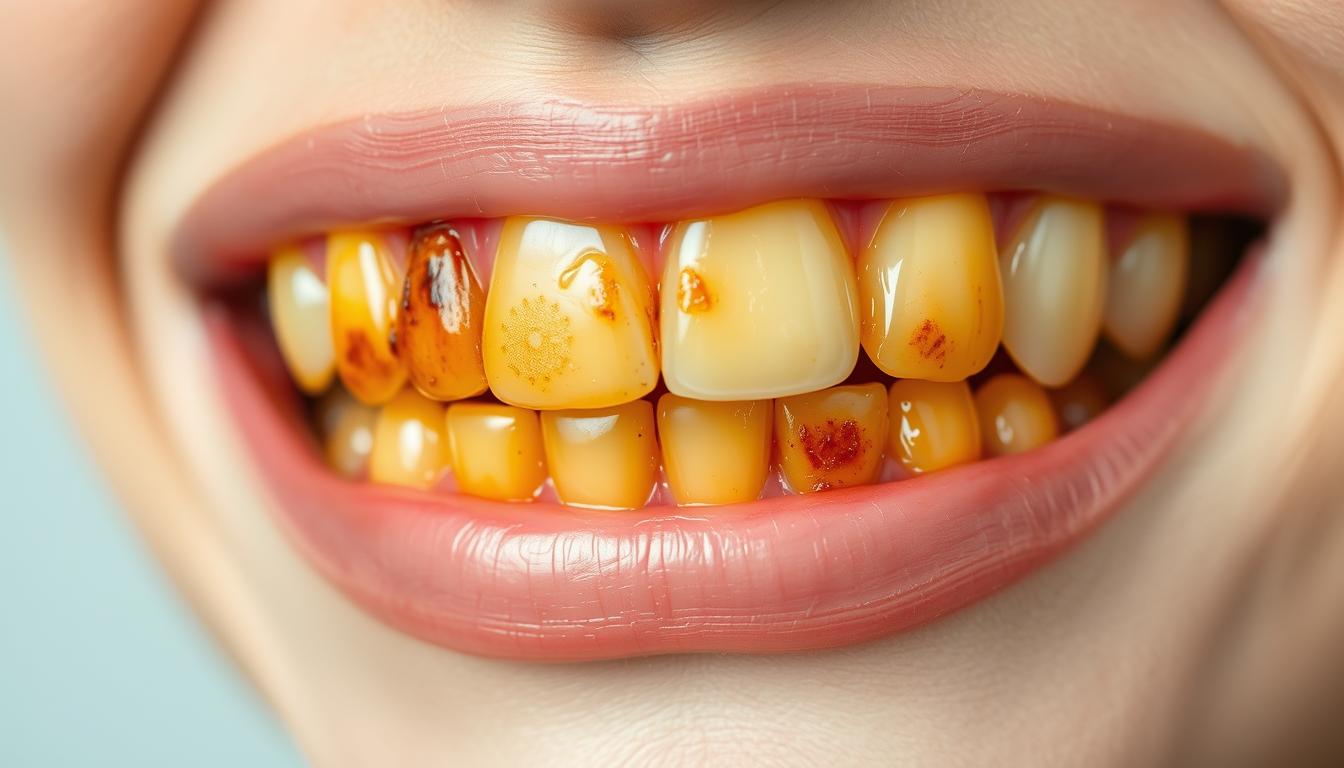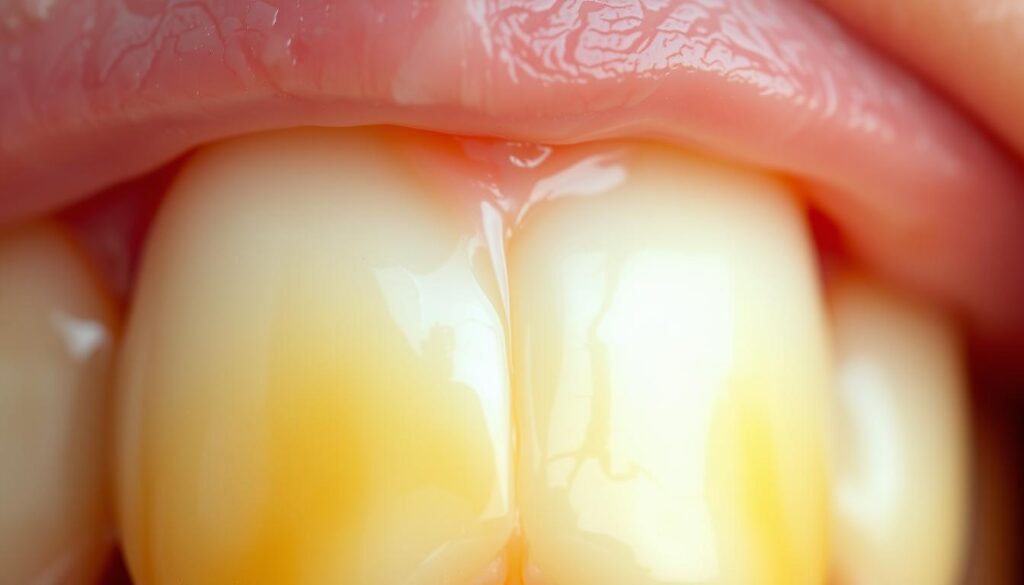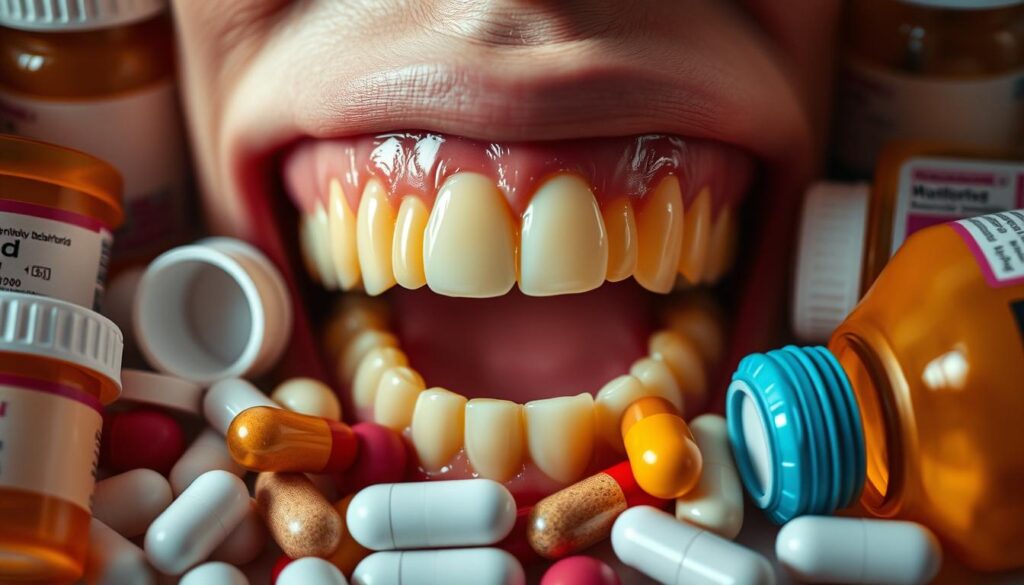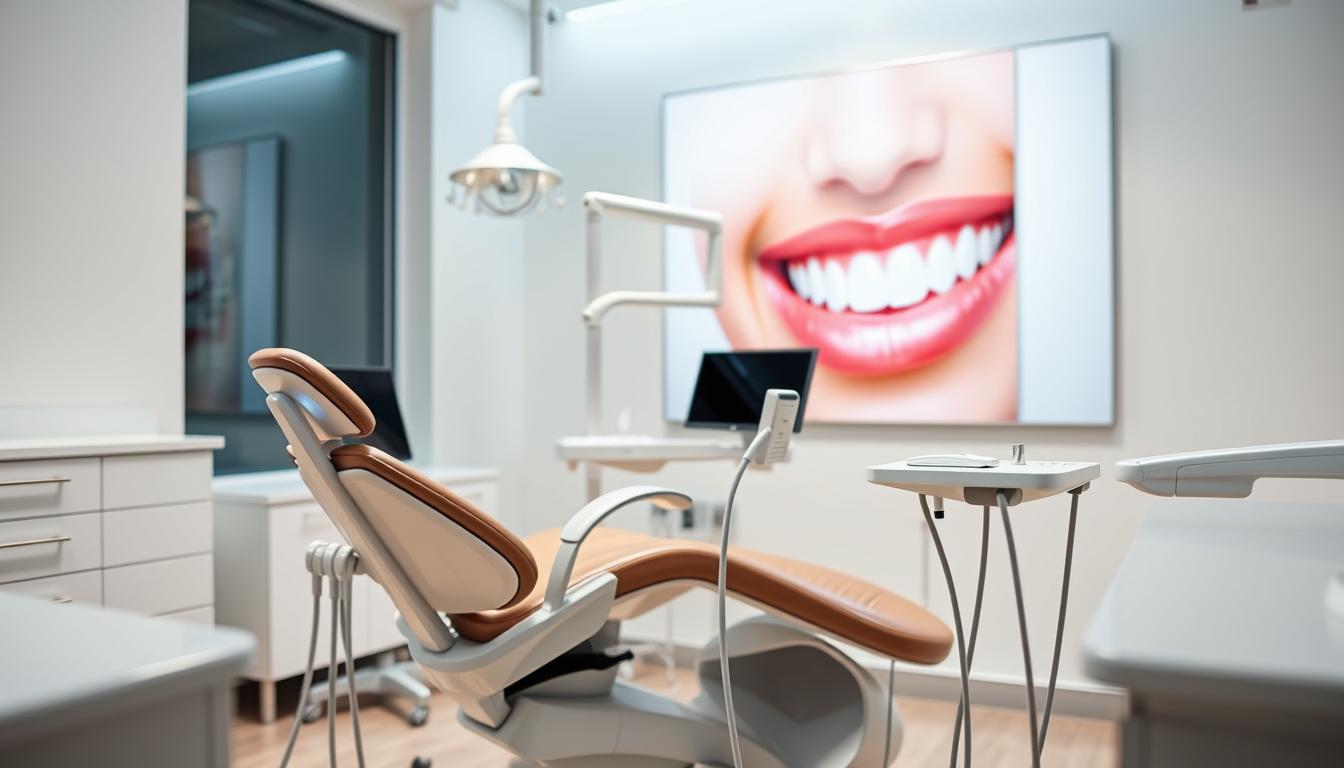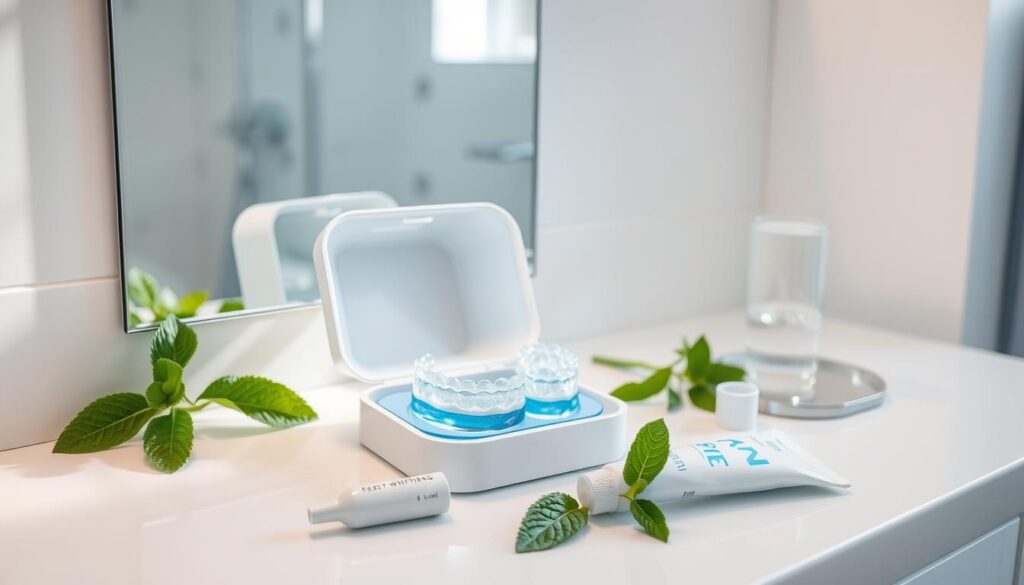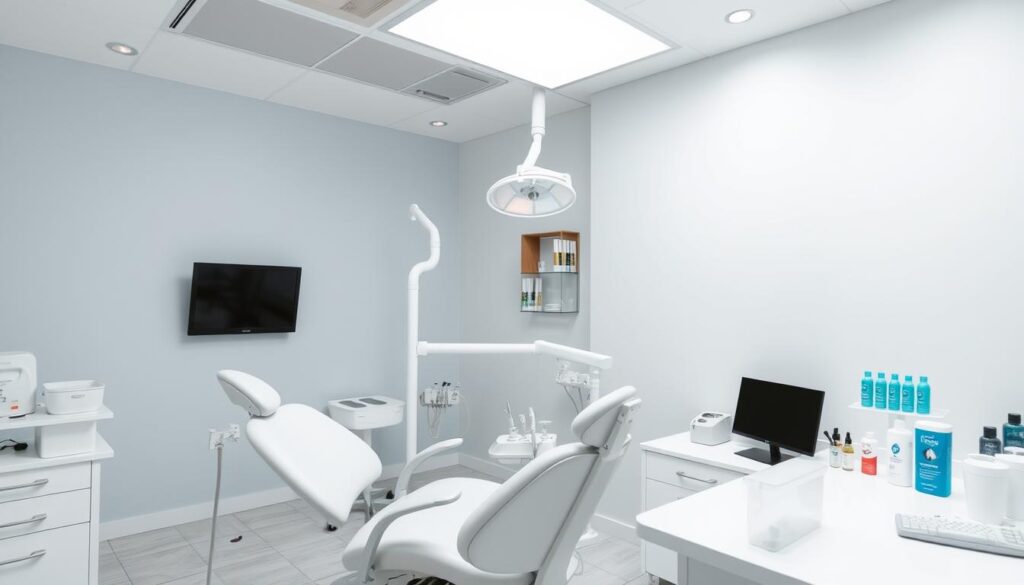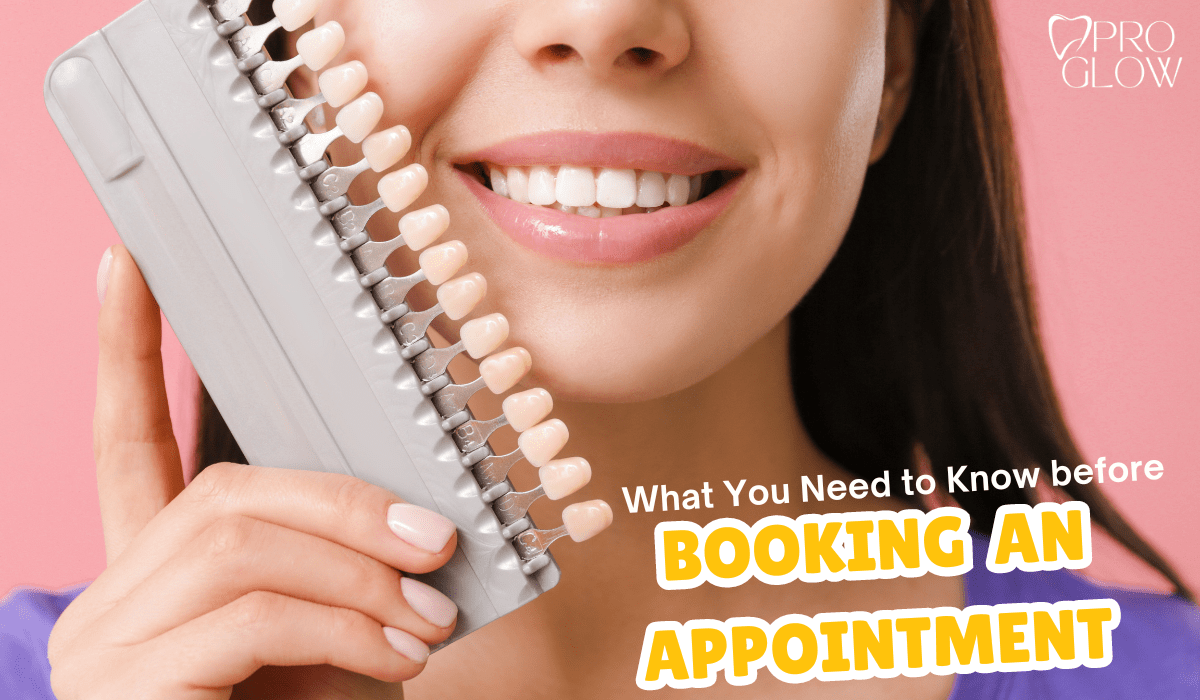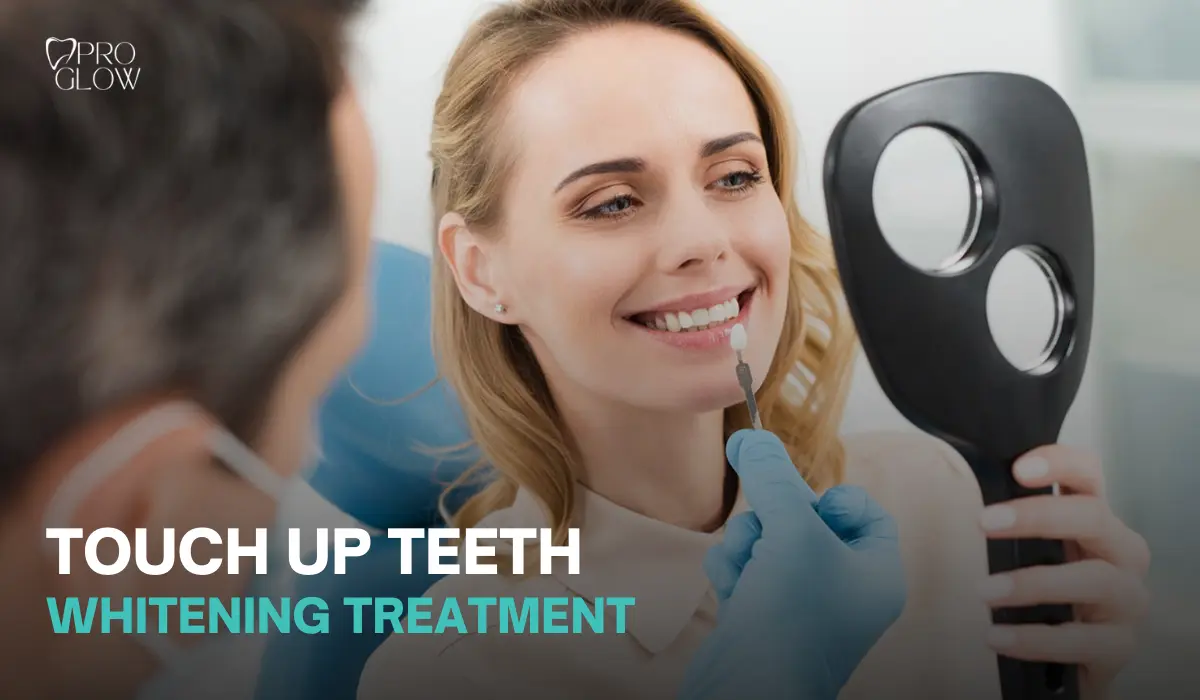Many of us dream of having a bright, white smile. But did you know your diet is key to keeping your teeth healthy and white? Eating certain foods can naturally make your teeth look better and keep your mouth healthy for a long time.
In this article, we’ll look at the top five foods that can make your smile whiter and healthier. We’ll talk about crunchy fruits and veggies, dairy, and superfoods that whiten teeth. You’ll learn how to get your brightest, most confident smile.
Key Takeaways
- Certain foods can naturally help whiten and strengthen your teeth.
- A balanced diet rich in teeth-friendly nutrients is essential for oral health.
- Incorporating crunchy fruits and vegetables, dairy products, and whitening superfoods can boost your smile’s appearance.
- Avoiding common staining culprits, like coffee and red wine, is also key for maintaining white teeth.
- Developing a tooth-friendly meal plan can make a significant difference in your dental well-being.
Understanding the Connection Between Diet and Dental Health
The foods we eat are key to keeping our teeth healthy and looking good. Tooth enamel, the hard outer layer of our teeth, is affected by what we eat. Some foods help strengthen it, while others can weaken it.
How Food Affects Tooth Enamel
Tooth enamel is made mostly of mineral-rich foods that are good for it. Foods rich in calcium, phosphorus, and fluoride are especially good for tooth enamel. These minerals help make enamel stronger, protecting it from acids and sugars in some foods.
The Role of Minerals in Tooth Strength
Mineral-rich foods also help keep our teeth strong and healthy. Minerals like calcium, phosphorus, and magnesium are key for strong teeth. Eating these mineral-rich foods helps us keep our oral health at its best.
| Mineral | Benefits for Tooth Health |
|---|---|
| Calcium | Strengthens tooth enamel and supports bone density in the jaw |
| Phosphorus | Aids in the mineralization and development of tooth structure |
| Fluoride | Enhances enamel remineralization and reduces the risk of cavities |
“Proper nutrition is essential for maintaining strong, healthy teeth. Incorporating a variety of mineral-rich foods into your diet can provide the necessary building blocks for robust tooth enamel and overall oral health.”
Foods that promotes white teeth
Getting a bright smile is easier than you think. It might just be about what you eat every day. Some teeth-whitening foods can naturally brighten your teeth. They also help with natural tooth care and a healthy enamel-friendly diet.
Strawberries are a great example. They have malic acid that gently removes stains. They also have vitamin C, which helps make saliva. Saliva washes away acids and food bits.
| Food | Whitening Benefit |
|---|---|
| Strawberries | Contain malic acid to remove stains and vitamin C to boost saliva production |
| Pineapple | Bromelain enzyme helps break down stains and plaque |
| Apples | Crunchy texture and high water content help scrub teeth clean |
| Celery | High fiber content and crunchy texture act as a natural toothbrush |
| Carrots | Rich in vitamin A, which supports enamel health |
Pineapple is another teeth-whitening food. Its bromelain enzyme breaks down stains and plaque. It also freshens your breath. Crunchy fruits and veggies like apples, celery, and carrots clean teeth naturally.
Eating these enamel-friendly foods can make your teeth whiter and healthier. You don’t need harsh chemicals. A natural tooth care approach is simple and effective for a bright smile.
The Power of Crunchy Fruits and Vegetables
Crunchy fruits and vegetables are not only tasty but also great for your teeth. They have a special power that keeps your smile bright and your teeth healthy.
Natural Teeth Cleaning Action
The crunchy texture of some foods, like apples and carrots, works like a natural toothbrush. When you bite and chew, it helps remove plaque and food bits. This makes your teeth feel clean and refreshed.
This natural cleaning effect is very helpful when you can’t brush your teeth right after eating.
Best Time to Eat Crunchy Foods
- The best time to eat crunchy vegetables and fruits is after meals.
- Chewing them helps make saliva, which cleans your mouth by neutralizing acid and removing food.
- Eating a crisp apple or carrot stick is a great way to end a meal and boost dental health.
Eating more crunchy vegetables and fruits helps keep your teeth clean and strong. It’s a simple, natural way to keep your smile bright and healthy.
Dairy Products: Nature’s Tooth Strengtheners
Dairy products are superheroes for healthy, white teeth. They are full of calcium and protein. These nutrients help make tooth enamel strong and fight cavities.
Cheese and yogurt are great for your teeth. Cheese has lots of calcium to help fix tooth enamel. Yogurt’s bacteria fight bad bacteria in your mouth. Eating more dairy for teeth can lower your risk of cavities.
Milk is also good for your teeth. It makes more saliva, which helps clean your mouth. This keeps your teeth and gums healthy.
“Dairy products are a powerhouse when it comes to dental health. The combination of minerals, proteins, and bacteria-fighting properties make them a must-have in any tooth-friendly diet.”
To keep your smile bright and healthy, eat more cheese and dental health supporting yogurt benefits. Your teeth will be grateful!
Strawberries and Their Natural Whitening Properties
Strawberries might just become your secret to a brighter smile. They contain malic acid, a compound that whitens teeth naturally.
Malic Acid Benefits
Malic acid in strawberries is a natural exfoliant. It gently removes stains and discoloration from your teeth. This process can make your smile look whiter without harsh chemicals.
How to Use Strawberries for Teeth Whitening
- Mash a few fresh strawberries into a smooth paste.
- Gently rub the strawberry paste onto your teeth, allowing it to sit for a few minutes.
- Rinse thoroughly with water to remove any residue.
- Repeat this process a few times a week for best results.
The mix of malic acid and strawberries for teeth whitening can greatly improve your smile. Enjoy this tasty fruit for a brighter, more confident smile.
“Strawberries are an unexpected yet effective tool in the quest for a whiter, brighter smile.”
Nuts and Seeds for Dental Health
Nuts and seeds are great for your teeth and overall health. They are full of protein and offer many dental benefits. They can satisfy your hunger and help keep your teeth white.
These snacks are packed with minerals. Almonds, for example, have lots of calcium, which is key for strong teeth. Pumpkin seeds have zinc, which helps stop plaque and gum problems. Eating them regularly can make your smile brighter and healthier.
Nuts and seeds also have a special texture that’s good for your teeth. Their crunchiness helps clean your teeth by removing food bits. It also makes your mouth produce more saliva, which fights off harmful acids.
- Almonds: High in calcium, promote strong enamel
- Pumpkin seeds: Rich in zinc, fight plaque and gum issues
- Walnuts: Contain antioxidants that may prevent gum disease
- Cashews: Stimulate saliva flow, helping to wash away bacteria
There are many ways to add nuts and seeds to your diet for better teeth. You can sprinkle them on salads or enjoy them as a snack. These protein-rich foods can be a big help for your oral health.
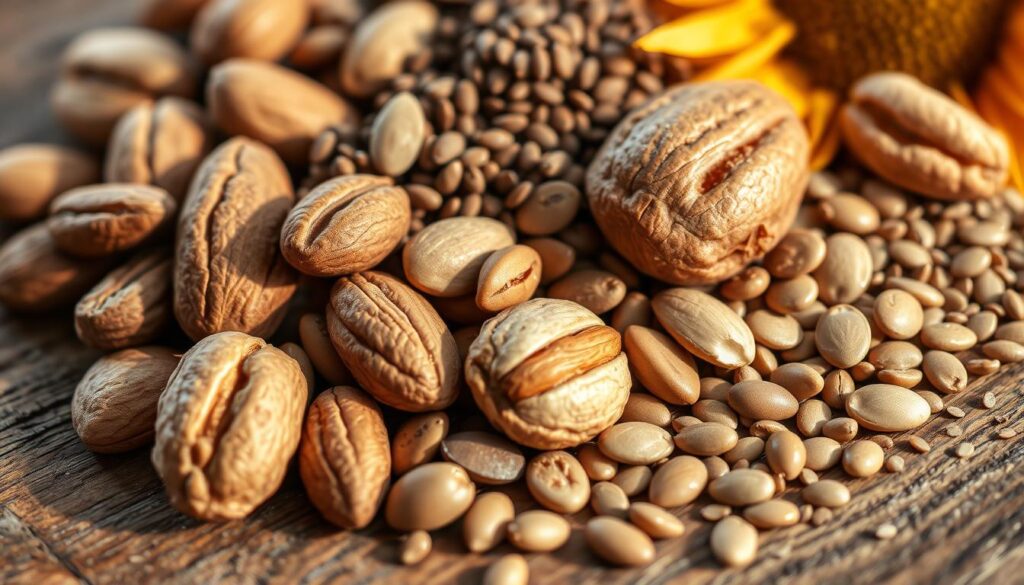
“Nuts and seeds are not only nutritious but can also play a crucial role in maintaining healthy, white teeth. Their mineral-rich composition and crunchy texture make them a fantastic addition to any tooth-friendly diet.”
The Benefits of Green Leafy Vegetables
Green leafy vegetables are key to a healthy smile. They’re not just good for your health, but also for your teeth. These veggies are packed with minerals and can even help whiten your teeth.
Mineral Content and Teeth Protection
Leafy greens like spinach and kale are full of calcium, phosphorus, and magnesium. These minerals are vital for strong teeth and preventing cavities. They help make your teeth more resistant to decay.
Best Greens for Dental Health
- Spinach – High in calcium and vitamin K, spinach helps build and maintain strong, healthy teeth.
- Kale – Packed with vitamins A, C, and K, kale supports the production of collagen, which is essential for gum health.
- Broccoli – This crunchy green is rich in iron, which can help prevent staining and discoloration of tooth enamel.
- Romaine lettuce – Loaded with vitamins A and C, romaine lettuce promotes the production of saliva, which helps neutralize acid and wash away food particles.
Eating a variety of leafy greens for teeth can greatly benefit your dental health. It’s a simple way to keep your smile bright and healthy.
Water: The Ultimate Dental Health Beverage
Good dental health is all about balance. One key part is staying hydrated. Water, simple as it is, is crucial for keeping your teeth and mouth healthy.
Drinking enough water is essential for a healthy mouth. It boosts saliva production, which is vital for water and oral hygiene. Saliva cleanses your mouth by removing food bits and acids that harm your teeth.
- More saliva keeps your mouth moist, preventing dry mouth. Dry mouth can cause many dental issues.
- Saliva also has minerals like calcium and phosphate. These minerals help strengthen and repair your teeth, making them whiter and healthier.
Water does more than just clean. It also helps keep your mouth’s pH balance right. By diluting acids, water keeps your mouth’s pH neutral. This is key for keeping your teeth strong and preventing stains.
“Drinking water is one of the simplest and most effective ways to support your dental health. It’s a natural, calorie-free way to keep your mouth hydrated and your teeth clean.”
Adding more water to your day is easy and cheap. Choose plain water or add fresh fruits for flavor. Drinking water regularly can greatly improve your teeth’s health and look.
| Benefit | Explanation |
|---|---|
| Increased Saliva Production | Water stimulates the production of saliva, which helps wash away food particles and neutralize acids that can erode tooth enamel. |
| Mineral Content Support | Saliva contains essential minerals like calcium and phosphate that strengthen and rebuild tooth enamel, contributing to whiter, healthier teeth. |
| pH Balance Regulation | Water helps dilute and flush away acidic substances, maintaining a neutral pH in the mouth, which is crucial for preserving tooth enamel and preventing discoloration. |
Foods to Avoid for Maintaining White Teeth
Keeping your teeth white is more than just brushing them. What you eat also matters a lot. Some foods and drinks can stain your teeth, making them look dull. Let’s look at some common culprits and find better choices for a brighter smile.
Common Staining Culprits
Red wine, coffee, and tea are big offenders. They can stain your teeth, making them lose their shine. Also, berries, soy sauce, and tomato-based sauces can cause discoloration.
Smart Alternatives to Staining Foods
- Try herbal tea or milk-based drinks like lattes or cappuccinos instead of coffee.
- If you love red wine, drink water between sips to cut down on staining.
- Choose lighter fruits and veggies like apples, pears, and celery. They can help clean your teeth.
It’s important to eat and drink in moderation. By choosing the right foods and drinks, you can keep your smile bright and healthy for a long time.

Creating a Tooth-Friendly Meal Plan
Keeping a dental health diet and balanced nutrition is key for white, healthy teeth. Planning your meals wisely helps support your oral health.
Begin by adding these tooth-friendly foods to your meal planning for white teeth:
- Crunchy fruits and veggies like apples, carrots, and celery clean your teeth and boost saliva.
- Dairy items like cheese, milk, and yogurt strengthen tooth enamel with calcium and phosphate.
- Leafy greens are full of minerals like calcium, iron, and magnesium, good for your teeth.
- Nuts and seeds offer a crunchy snack and important vitamins and minerals.
- Water is the best drink for rinsing away food and bacteria.
Try to balance these dental health diet foods in your meals. For instance, start with a yogurt parfait with berries and nuts for breakfast. Have a crunchy salad with greens for lunch. And drink milk with dinner.
“A well-balanced, nutrient-rich diet is the foundation for a healthy smile.”
By choosing wisely and meal planning for white teeth, you can create a dental health diet that keeps your teeth shining.
Tips for Maximizing Food Benefits for Dental Health
Keeping your smile healthy is more than just brushing and flossing. Your diet is key to strong, white teeth. By mixing the right oral hygiene habits with smart food combinations for teeth, you boost your eating for dental health efforts. Here are some tips to enhance your tooth-friendly diet:
- Pair crunchy fruits and vegetables with dairy products. Crunchy foods remove plaque, while dairy strengthens enamel.
- Drink water all day to clean your mouth and help saliva fight acid and bacteria.
- Snack on nuts and seeds. They’re good for gums and teeth with their fiber and minerals.
- Add green leafy veggies to your meals. They’re full of vitamins and minerals that fight tooth decay and gum disease.
- Have staining foods like coffee and red wine with crunchy, water-rich foods to reduce stains.
By adding these easy steps to your daily life, you can make your diet better for your teeth. This will help you keep a bright, healthy smile for many years.
“A balanced, tooth-friendly diet combined with good oral hygiene habits is the foundation for a lifetime of dental health.” – Dr. Sarah Samson, Dentist
Conclusion
Maintaining a bright, healthy smile is more than just looks. It shows our overall health. By eating natural teeth whitening foods and making smart diet choices, we can take care of our teeth. This brings us the confidence of having a radiant smile.
This article has shown us foods that are good for our teeth. Crunchy fruits and veggies, dairy products, and green leafy greens are all great. They help strengthen our enamel, reduce stains, and whiten our teeth naturally. Simple changes in our diet can lead to a brighter smile and better dental health.
Keeping a bright smile is a long-term effort. Staying consistent is crucial. Drinking water, avoiding stain-causing foods, and planning tooth-friendly meals are key. Let’s use natural teeth whitening to make our smiles shine. This will show our confidence and health to the world.
FAQ
What are the best foods to eat for promoting white teeth?
Crunchy fruits and veggies, dairy, strawberries, nuts, and green leaves are great. They help strengthen enamel and whiten teeth naturally.
How does food affect tooth enamel and dental health?
What you eat affects your teeth’s health and look. Some foods can make enamel stronger, while others can weaken it. Strong enamel is key for white, healthy teeth.
What are the natural teeth-cleaning benefits of crunchy fruits and vegetables?
Foods like apples and carrots clean teeth naturally. Their texture and water content remove plaque and food, making your smile brighter.
How do dairy products contribute to stronger, whiter teeth?
Dairy like cheese and milk has calcium and protein for strong enamel. Calcium also fights acid and remineralizes teeth, keeping them white.
What makes strawberries effective for natural teeth whitening?
Strawberries have malic acid that gently removes stains. Their antioxidants also help prevent discoloration and support dental health.
How can nuts and seeds benefit dental health?
Nuts and seeds are full of nutrients for strong teeth. Their crunchy texture also helps clean the mouth, promoting health.
What are the dental health benefits of green leafy vegetables?
Leafy greens like spinach are rich in minerals for enamel. They also help neutralize acid and prevent discoloration.
How does water consumption impact dental health?
Drinking water is key for dental health. It boosts saliva, which cleanses the mouth, neutralizes acid, and remineralizes teeth.
What are some common staining foods and beverages to avoid for maintaining white teeth?
Avoid coffee, tea, red wine, and dark sauces to keep teeth white. Opt for herbal tea or fruit water instead.


